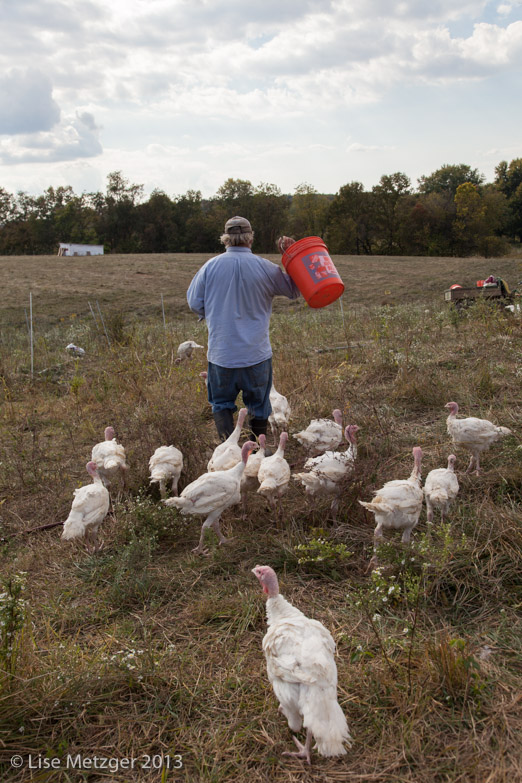 This time of year, most people only have two questions on their mind:
This time of year, most people only have two questions on their mind:
1) Why has the Christmas music started already?
2) Where am I going to get my Thanksgiving turkey?
Although I can’t explain away Burl Ives songs in early November, I’m more than happy to take orders for bonafide free-range turkeys. While holiday songs will soon saturate the airwaves, genuine free-range turkeys are typically rarer than hen’s teeth this time of year. So what can farmers do to provide more free-range birds, supplying a legion of customers hungry for an authentic product?
First things first. In order to sell the turkeys, we have to raise the turkeys. In that spirit, here’s a list of tips that I’ve accumulated over ten years of pastured turkey raising.
1) The first three weeks are the most critical
Turkey poults are incredibly fragile for the first three weeks… before becoming significantly more hardy. The purpose of the brooder is to imitate the warm, safe conditions beneath a mother hen. That said, mortality in the brooder can be extremely high, with producers routinely experiencing losses in excess of 25%. That kind of attrition can be very discouraging to a first time farmer.
This year we raised nearly 500 turkeys, and lost less than 20 in the brooder—a 4% death rate. We accomplished this by following 3 main rules:
1) Keep it stifling hot inside the brooder, between 95-100 degrees, with high humidity. We use an exhaust fan with both a temperature and humidity sensor on it. 2) Build your brooder draft-free. The occasional cold breeze at night seems to really affect baby chicks. 3) Check on them hourly throughout the day. Baby poults are especially prone to flip onto their backs, and suffocate themselves. Give ‘em a flip and send them on their way.
2) Get them started correctly
Don’t cut corners on feed. Turkeys need 26% protein for at least the first month, before leveling down to 21% (we then finish them on 17% for the final few weeks). Also, we use Fetrell’s Poultry Nutribalancer in all of our feed, and have virtually no leg issues. As the old saying goes, “Feed animals to MAKE money, not SAVE money.” Feed them correctly, and you will save on time and deferred expenses in the long run.
Btw, we’ve never used medicated feed (antibiotics) in any of our turkey feed, not even as poults. Part of our daily chores is raking, aerating and adding clean bedding (pine shavings) to the brooder.
3) Give ‘em grit!
It’s crucial to give turkeys constant access to granite grit from day one. Also, the size of the pebble must be increased as they grow. Once they get onto pasture (for us, we turn them loose around week 7, or after the dander has disappeared from their heads) they will go straight to gobbling up grass. They need proper amounts of grit in their gizzards to help grind that fibrous pasture into soluble nutrition, truly supplementing their diet.
4) Turkeys love to roost
Don’t try to argue with the turkeys on this one. I’ve built all manner of turkey hutches, and instead of the birds sleeping inside of them at the end of the day, they invariably prefer to roost on TOP of them. This year, we build a mobile roost on the back of an old hay wagon running gear, topped it with a modest roof, hooked up some automatic bell waterers, and we were ready to roll.
The turkeys roost up high at night, away from any predators that might breach our electric nets. At a retail price of about $75 per turkey, nothing is quite as discouraging as seeing a big pile of feathers in the morning where a turkey once was. So allow them to roost, and let them help protect themselves.
5) Give them plenty of room
With any luck, little turkeys grow into big turkeys. Keeping that in mind, it’s still easy to underestimate the amount of space you’ll need to allocate once the birds arrive on the pasture. A basic rule of thumb is 10 acres for every 200 turkeys. This gives enough grass to make a daily rotation of about a quarter acre, while ensuring the field is given ample time to recover. After all, these are pastured turkeys, right? Make sure to set aside plenty of late summer/early fall forage for your flock of hungry birds.
6) Customers like two sizes: 10-12ish, and gargantuan
Last but not least, after over a decade of raising turkeys, customer preference in my neck of the woods boils down to two categories. 95% of all requests fall into the 10-12 category (we also offer 13-14 pounders, because it’s nearly impossible to raise them so precisely). The other 5% of folks, however, want a Godzilla turkey.
As the farmer who actually raises and processes these turkeys, I know how much time and money I’ve invested in each bird. Because of this, I’d rather have them dressed and frozen at week 14, instead of extending my risk, chores and feed for another month and a half. Additionally, wrestling a 14 pound (live weight) turkey is hard enough. But try coercing a 26 pound tom upside down into a kill cone! Literally and figuratively, it’s for the birds.
Here’s a bit of salesmanship: instead of one 24 pounder, suggest two 12 pounders. Many customers don’t realize that most modern ovens can’t even accommodate the massive girth of a twenty-something pound turkey. You might just be saving your customer from major disappointment by the time they realize their mistake.
✺ ✺ ✺ ✺ ✺
So to all you free-range turkey farmers out there (or aspiring turkey farmers), Happy Thanksgiving! Here’s to a season of healthy turkeys, perfect pastures, and happy customers. Save a slab of dark meat for me, and please pass the cranberry sauce.
Check out my books!












Leave a Reply